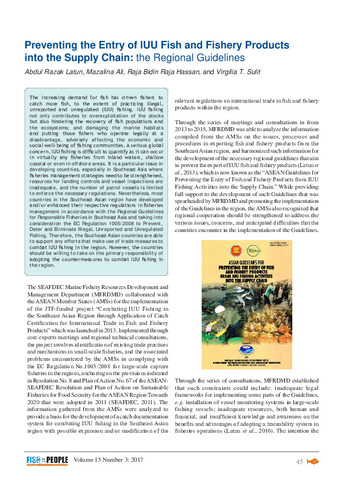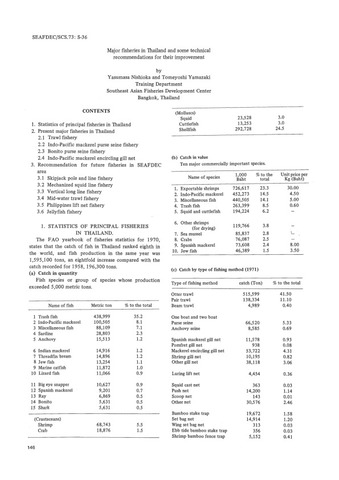ສະແດງບັນທຶກທີ່ງ່າຍດາຍສໍາລັບລາຍການ
Preventing the entry of IUU fish and fishery products into the supply chain: the regional guidelines
Share
| dc.contributor.author | Latun, Abdul Razak | |
| dc.contributor.author | Ali, Mazalina | |
| dc.contributor.author | Hassan, Raja Bidin Raja | |
| dc.contributor.author | Sulit, Virgilia T. | |
| dc.date.accessioned | 2018-03-20T02:09:46Z | |
| dc.date.available | 2018-03-20T02:09:46Z | |
| dc.date.issued | 2017 | |
| dc.identifier.issn | 1685-6546 | |
| dc.identifier.uri | http://hdl.handle.net/20.500.12066/1287 | |
| dc.description.abstract | The increasing demand for fish has driven fishers to catch more fish, to the extent of practicing illegal, unreported and unregulated (IUU) fishing. IUU fishing not only contributes to overexploitation of the stocks but also hindering the recovery of fish populations and the ecosystems; and damaging the marine habitats and putting those fishers who operate legally at a disadvantage, adversely affecting the economic and social well-being of fishing communities. A serious global concern, IUU fishing is difficult to quantify as it can occur in virtually any fisheries from inland waters, shallow coastal or even in offshore areas. It is a particular issue in developing countries, especially in Southeast Asia where fisheries management strategies need to be strengthened, resources for landing controls and vessel inspections are inadequate, and the number of patrol vessels is limited to enforce the necessary regulations. Nevertheless, most countries in the Southeast Asian region have developed and/or enhanced their respective regulations in fisheries management in accordance with the Regional Guidelines for Responsible Fisheries in Southeast Asia and taking into consideration the EC Regulation 1005/2008 to Prevent, Deter and Eliminate Illegal, Unreported and Unregulated Fishing. Therefore, the Southeast Asian countries are able to support any efforts that make use of trade measures to combat IUU fishing in the region. However, the countries should be willing to take on the primary responsibility of adopting the countermeasures to combat IUU fishing in the region. | en |
| dc.language.iso | en | en |
| dc.publisher | Secretariat, Southeast Asian Fisheries Development Center | en |
| dc.subject | South East Asia | en |
| dc.title | Preventing the entry of IUU fish and fishery products into the supply chain: the regional guidelines | en |
| dc.type | magazineArticle | en |
| dc.citation.volume | 15 | |
| dc.citation.issue | 3 | |
| dc.citation.spage | 45 | |
| dc.citation.epage | 48 | |
| dc.citation.journalTitle | Fish for the People | en |
| dc.subject.asfa | offshore | en |
| dc.subject.asfa | fisheries | en |
| dc.subject.asfa | fish | en |
| dc.subject.asfa | developing countries | en |
| dc.subject.asfa | ecosystems | en |
| dc.subject.asfa | fishery management | en |
| dc.subject.asfa | illegal fishing | en |
| dc.subject.asfa | stocks | en |
| dc.subject.asfa | guidelines | en |
| dc.subject.asfa | fishing communities | en |
| dc.subject.asfa | fishery products | en |
| dc.subject.asfa | overexploitation | en |
| dc.subject.asfa | inland waters | en |
| dc.subject.asfa | fishing | en |
| dc.subject.asfa | countries | en |
| dc.subject.asfa | fishers | en |




